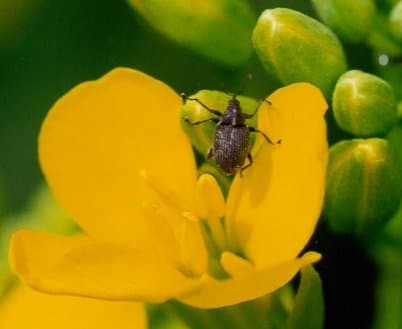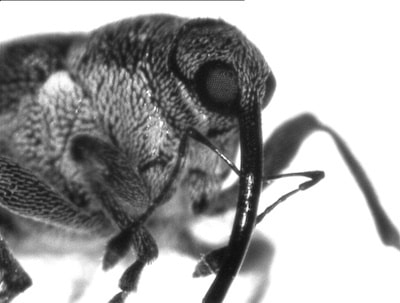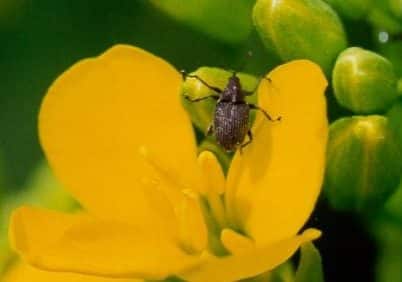

Cabbage seedpod weevils move to canola fields at the bud to early-flower stages. The recommended crop stage to spray for seedpod weevils is around 20% flower (which is about a week after you see the first flower in the field). Many weevils may be present at the bud-rosette stage but one cannot sweep at that stage and spraying is not recommended at that time because it is too early.
On days above 12°C with low to moderate wind, weevils will be concentrated in the top area of the crop. In these conditions, they are easy to pick up with a sweep net.
Cabbage seedpod weevil nominal thresholds are based on sweep net numbers, which requires proper sweep net technique. Select 10 locations within each field and at each location, count the number of weevils from ten 180° sweeps. Sample both the perimeter and interior of the field to obtain an accurate estimate of weevil numbers throughout the field.
The nominal economic threshold for weevil is 20-40 in 10 sweeps (2-4 per sweep). Anything below that and canola plants will generally compensate for seedpod weevil damage to the buds and flowers.
Don’t spray too soon. Products registered for cabbage seedpod weevil can be sprayed only once per year, so correct timing is important. Also note that if a product has already been used on flea beetles, it may not be available for use again in that crop if the label permits only one use per crop per season.
If you have the earliest crops in the area:
Healthy crops with good plant counts are going to compensate well from weevil feeding on buds. CSPW do their most costly damage at the podding stage by laying eggs in the pods. (Larvae emerging from these eggs can eat the seeds in a pod.) Growers may choose to hold off on weevil spraying at the flowering stage and save that spray for when early pods are about an inch long — which is when the majority of the egg laying begins.
Crops that are under stress (low plant counts, drought, heat, flooding) are more likely to set back by bud feeding. In that case, spraying at 10% to 30% flowering may pay off if fields have even fewer than 2-3 weevils per sweep. But beware there still may be another invasion, and you may want to save your spray. The Prairie Pest Monitoring Network provides more identification and monitoring tips: 2010_CSPW protocol
Growers spraying to control adult weevils at the flowering stage could leave a check strip to see how well the product worked. At harvest, compare plants in the check strip and in the sprayed field to see what percentage of pods have exit damage from weevil larvae feeding inside the pod and then exiting.
Check throughout the field. Cabbage seedpod weevils enter a field from the side and work their way to the middle. Scouting borders of fields twice a week may allow you to catch their first arrival, possibly allowing adequate control with a perimeter spray of the outside edges of the field. Shelterbelts and fence lines are a good clue as to which side might be first, but check all four to be safe. Also, continue to scout after application if relying on perimeter sprays (keeping in mind safe field re-entry times), in case re-invasion occurs.

